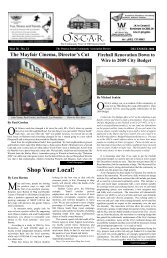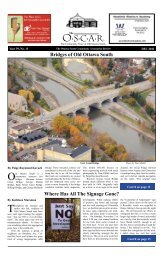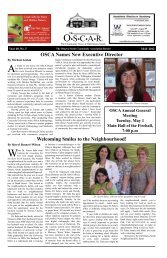Create successful ePaper yourself
Turn your PDF publications into a flip-book with our unique Google optimized e-Paper software.
Page 14<br />
By Abraham Plunkett-<br />
Latimer<br />
This month’s contribution to<br />
the <strong>Ottawa</strong> <strong>South</strong> History<br />
Project comes from one of<br />
our Heritage Survey 2009 summer<br />
students, Abraham Plunkett-Latimer,<br />
an M.A. student in the Department<br />
of History, Carleton University. This<br />
article will be part of the Heritage<br />
Survey 2009 report to be presented<br />
to the <strong>Old</strong> <strong>Ottawa</strong> <strong>South</strong> community<br />
later this year.<br />
Property<br />
Address: 66 Barton Street (Lot 2,<br />
West Side Barton Avenue)<br />
Introduction<br />
The home at 66 Barton Street is<br />
a large, two-story, brick, cross-gable<br />
home built in 1897 by Jacob Vincent<br />
Poaps, an aspiring <strong>Ottawa</strong> merchant.<br />
It remained in the Poaps family<br />
throughout almost the entire twentieth<br />
century until 1987.<br />
History<br />
The home currently located at 66<br />
Barton Street in <strong>Ottawa</strong>, Ontario was<br />
built on lot 2 of an 1895 subdivision<br />
in <strong>Old</strong> <strong>Ottawa</strong> <strong>South</strong>. The property<br />
was owned by George and James<br />
McLean, who lived in <strong>Old</strong> <strong>Ottawa</strong><br />
<strong>South</strong>. James reportedly owned a sand<br />
pit at the corner of Bank and Euclid<br />
Streets. George, his brother, is referred<br />
to as a “merchant” in nineteenthcentury<br />
city directories. In 1895, they<br />
subdivided their land into 24 lots<br />
ranging from 6000 to 7000 square<br />
feet. The subdivision was unusually<br />
modest in size for <strong>Old</strong> <strong>Ottawa</strong> <strong>South</strong>.<br />
Nearly the entire area of the modern<br />
neighbourhood had been subdivided<br />
in large swaths by major industrialists<br />
The OSCAR - OUR 37 th YEAR<br />
OTTAWA SOUTH HISTORY PROJECT<br />
Poaps House – 66 Barton Ave<br />
in 1891. This large scale development<br />
was, according to Bruce Elliott, based<br />
on speculation that a streetcar running<br />
down Bank Street would quickly raise<br />
property values and help to develop<br />
economically the then rural area.<br />
Lot 2 was first bought by Jennet<br />
(Jennie) Anne Poaps (nee McLean)<br />
in 1896, the first year the lots became<br />
available. Jennet Poaps was a younger<br />
sister of James and George McLean,<br />
suggesting that the subdivision was<br />
. 66 Barton Street. Window Detail. Photo by A Plunkett-Latimer,<br />
66 Barton Street Photo by Jean-Claude Dubé<br />
largely a family enterprise rather than<br />
big business. It is likely that a home<br />
was built at 66 Barton Street as early<br />
as 1897, as the <strong>Ottawa</strong> City Directory<br />
for that year lists the Poaps family as<br />
living there. Jennet Poaps used the<br />
property to provide a mortgage to<br />
Louisa C Biggar for $1500.<br />
Jennie Poaps’s husband was Jacob<br />
Vincent Poaps, who originated in<br />
Onasbruck Township. It is uncertain<br />
when he moved to <strong>Ottawa</strong> exactly,<br />
July 2010<br />
though as early as 1895 he owned<br />
a wholesale boot and shoe store on<br />
Wellington Street along with William<br />
Lamb and Donald McDonald. By<br />
1899, Jacob Poaps had formed the JV<br />
Poaps and Son, which is described as<br />
a Manufacturers Agents company in<br />
the 1899 City Directory.<br />
It appears as though the Poaps’<br />
company became quite profitable, as<br />
in 1915 they were granted a patent to<br />
incorporate their company. A letter<br />
from Thomas Mulvey, the Under-<br />
Secretary of State in 1915 stated that<br />
JV Poaps and Co. Ltd. would be worth<br />
$40,000 in capital stock divided into<br />
400 shares. Despite their seeming<br />
optimism, however, the company<br />
went bankrupt in 1921 and was sold<br />
at a loss to a Detroit company called<br />
International Feldspar Co. In 1922,<br />
Jacob Vincent Poaps died, his wife<br />
Jennet dying shortly afterwards in<br />
1924.<br />
After Jacob and Jennet Poaps’s<br />
deaths 66 Barton was rented for<br />
several years to a Martin S. Grace,<br />
yet title remained in the hands of the<br />
Poaps family. In 1929 John Douglas,<br />
Jacob and Jennet’s youngest child,<br />
and his wife Florence moved into the<br />
home. John Douglas and Florence<br />
Poaps remained in the home until<br />
Florence’s death in 1987 after which<br />
it was sold to Alan Duncan McKinley.<br />
The city directories do not<br />
indicate what profession John Poaps<br />
held. In 1933, however, perhaps as a<br />
result of the great depression, Poaps<br />
began to rent out an apartment at<br />
66 Barton while continuing to live<br />
there. By 1961 this apartment was<br />
Cont’d on next page










